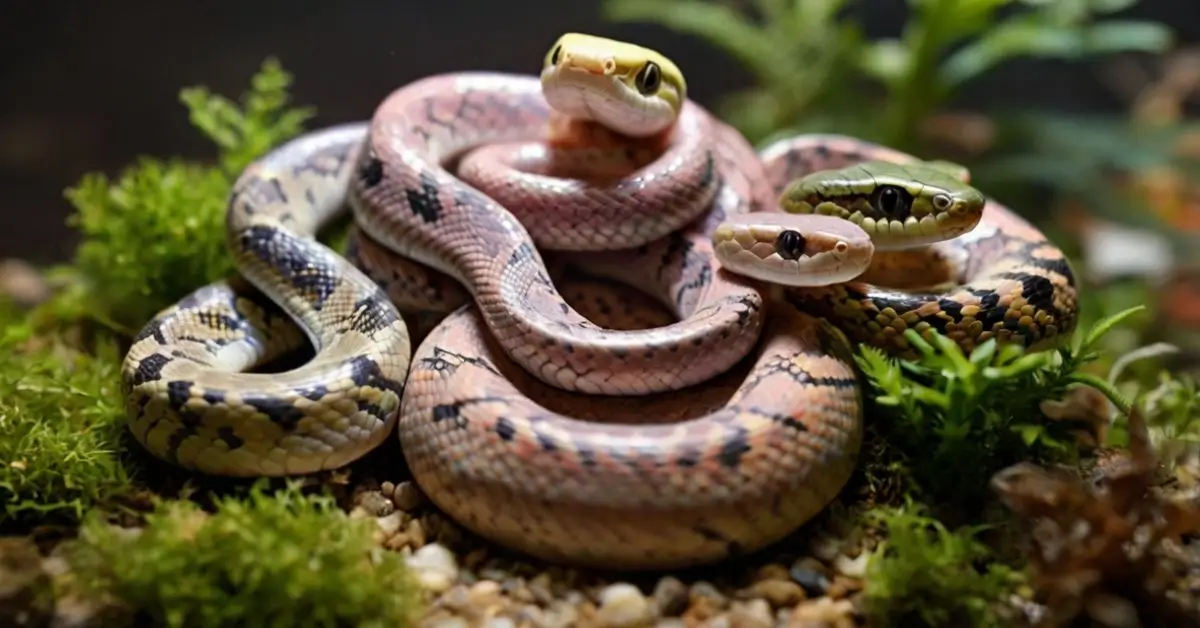Little pet snakes are becoming increasingly popular among pet enthusiasts who crave something unique, low-maintenance, and fascinating to observe. These compact reptiles make excellent pets for beginners due to their manageable size, ease of care, and captivating behavior. Whether you’re a first-time snake owner or looking to add a smaller species to your collection, this guide offers everything you need to know.
From species selection to habitat setup, dietary needs to common health issues, this article covers the essential details to help you make an informed decision. Let’s dive into the world of little pet snakes and discover why they’re perfect for reptile lovers of all ages.
Why Choose Little Pet Snakes?
Little pet snakes offer a combination of convenience and curiosity. These reptiles are easy to care for and take up less room than conventional pets. Your All-Inclusive Guide to Scaly, Small Pets
Compact Size, Big Personality
Their small size means they don’t need large enclosures. A 10–20 gallon terrarium is usually sufficient. Despite being small, they are full of personality and exhibit fascinating behaviors like burrowing, climbing, and coiling.
Low Feeding Frequency
Most of the pet snakes feed once every 7–14 days, making them ideal for people with busy schedules. Frozen-thawed prey options are also available, making feeding safer and cleaner.
Hypoallergenic and Quiet
If you’re allergic to fur or live in an apartment with noise restrictions, little snakes offer a hypoallergenic and silent alternative to dogs or cats.
Best Little Pet Snake Species for Beginners
Choosing the right species is essential for a positive experience. Here are the top beginner-friendly pet snakes:
Corn Snake
Known for their docile temperament and vibrant colors, corn snakes are among the most popular small snake species. They’re easy to handle and thrive in captivity.
Rosy Boa
Rosy boas are gentle and rarely show aggression. Their slow movements and calm demeanor make them excellent pets for children and beginners alike.
Western Hognose Snake
Western hognose snakes are interesting and easy to handle because of their peculiar demeanor and upturned snout. They typically stay under 3 feet long and adapt well to captivity.
Kenyan Sand Boa
This burrowing species prefers to stay hidden, but they’re easy to care for and very docile. Their small size and interesting habits make them a favorite among enthusiasts.
Ball Python (Juvenile)
Although adult ball pythons can grow larger, juveniles remain small for several years and are incredibly tame. They’re slow-moving and easy to handle.
Habitat Requirements for Pet Snakes
Creating a comfortable environment is key to keeping your pet snakes healthy and stress-free.
Enclosure Size
Most small species thrive in enclosures ranging from 10 to 20 gallons. Make sure the enclosure has:
- A secure lid
- Substrate for burrowing
- Hiding spots
- Water dish
- Climbing accessories for semi-arboreal snakes
Heating and Lighting
Snakes are ectothermic and need a thermal gradient to regulate their body temperature. Make use of a ceramic heater or heat mat to keep:
- Warm side: 85°F–90°F
- Cool side: 75°F–80°F
Provide a 12-hour light-dark cycle using natural or low-intensity lighting. Avoid UVB unless required by the species.
Humidity and Ventilation
Humidity levels vary by species, but generally fall between 40% and 60%. Mist the enclosure lightly and ensure good airflow to prevent mold and respiratory issues.
Substrate Options
Substrates like aspen shavings, coconut fiber, or reptile carpet work well. Steer clear of pine and cedar because they emit toxic oils.Spot-clean daily and deep-clean every two weeks.
Feeding Your Little Pet Snakes
Feeding is one of the easiest aspects of snake care. Most little pet snakes eat mice or small rats.
Frozen vs. Live Prey
Frozen-thawed rodents are safer and more humane. Before feeding, fully thaw the prey and bring it to body temperature. Make use of a ceramic heater or heat mat to keep:
Feeding Schedule
- Hatchlings: Every 5–7 days
- Juveniles: Every 7–10 days
- Adults: Every 10–14 days
Feed in a separate container to prevent ingestion of substrate and encourage a feeding response.
Hydration
Always provide clean, fresh water. Use a shallow dish large enough for soaking. Change water daily to prevent bacterial growth.
Common Health Issues in Little Pet Snakes
Regular health monitoring ensures your pet thrives. Watch for these common issues:
Mites and Parasites
These external pests appear as small black dots on the snake’s scales. Bathe the snake and disinfect the enclosure if mites are detected.
Respiratory Infections
Symptoms include wheezing, open-mouth breathing, and mucus discharge. These infections often result from low temperatures or poor ventilation.
Shedding Problems
Incomplete sheds may indicate low humidity. Provide a humidity hide and increase ambient moisture levels.
Anorexia
Occasional refusal to eat is normal, especially before shedding. Persistent anorexia, however, may signal stress, illness, or poor husbandry.
Comparison Chart: Best Little Pet Snakes
| Snake Species | Size (ft) | Temperament | Lifespan | Care Difficulty | Ideal For |
| Corn Snake | 3–5 | Very docile | 15–20 yrs | Easy | Beginners |
| Rosy Boa | 2–3 | Gentle and slow | 20+ yrs | Very easy | Families |
| Western Hognose | 1.5–2.5 | Playful and curious | 12–18 yrs | Easy | Intermediate |
| Kenyan Sand Boa | 1.5–2 | Shy but calm | 15+ yrs | Very easy | First-timers |
| Juvenile Ball Python | 2–3 | Calm and slow | 25–30 yrs | Moderate | Beginners/Teens |
Handling and Interaction
Handling your little pet snakes helps build trust and makes them more sociable.
How to Handle Properly
- Always wash hands before and after handling
- Support the entire body
- Avoid sudden movements
- Do not handle right after feeding or during shedding
Supervision with Kids
Children should always be supervised. Teach them how to handle the snake gently and avoid squeezing or grabbing its head.
Enrichment and Mental Stimulation
Even small reptiles enjoy environmental variety. Here’s how to keep little pet snakes active and happy.
Hideouts
Provide multiple hiding spots throughout the enclosure. Use cork bark, reptile caves, or DIY options.
Climbing Accessories
Branches, vines, and climbing ledges cater to the natural behaviors of semi-arboreal species.
Scent Trails
Introduce new scents using safe materials like reptile-safe leaves or unscented tissue. This encourages natural exploratory behavior.
Traveling with Little Pet Snakes
You may occasionally need to travel with your tiny pet snakes, whether to the vet or while relocating.
Short Trips
Make use of a little, paper towel-lined container with ventilation. Maintain temperature with heat packs in cooler weather.
Longer Absences
Arrange a caretaker or professional reptile sitter. Provide detailed care instructions, feeding schedules, and emergency contacts.
Ethical and Legal Considerations
Before acquiring tiny pet snakes, research local laws. Some jurisdictions require permits or ban specific species.
Ethical Sourcing
Always buy from reputable breeders or adoption centers. Wild-caught snakes may carry diseases and struggle to adapt to captivity.
Captive-Bred Advantages
Captive-bred snakes are healthier, better socialized, and easier to handle. Supporting ethical breeding also reduces pressure on wild populations.
Myths About tiny Pet Snakes
Many misconceptions surround snakes. Here are a few you can safely ignore:
- Snakes are slimy: In fact, their skin is dry and smooth.
- They are dangerous: Most tiny pet snakes are non-venomous and very safe.
- They don’t bond with humans: While they may not bond like dogs, snakes recognize familiar handlers and show calm behavior in response.
Lifespan and Long-Term Commitment
Owning tiny pet snakes is a long-term responsibility. With the right care, some surpass 20 years of age.
- Regular feeding and cleaning
- Annual veterinary checkups
- Mental stimulation
- Proper housing upgrades over time
Conclusion
Little pet snakes are the perfect pets for individuals who want a quiet, hypoallergenic, and low-maintenance companion. They are not only easy to care for but also incredibly fascinating to observe and interact with. With the right habitat, diet, and handling, these small serpents can become cherished pets for years to come. Whether you’re a first-time pet owner or a reptile enthusiast, tiny pet snakes provide a unique and rewarding experience that’s unlike any other pet.
FAQ’s:
What is the most beginner-friendly little pet snake?
Corn snakes are often recommended due to their calm demeanor, small size, and low maintenance needs.
How often little pet snakes need to eat?
Most species need to eat once every 7 to 14 days depending on their age and size.
Are tiny pet snakes safe for kids?
Yes, they are generally safe. With supervision and proper handling, they make great pets for older children.
Do little pet snakes need special lighting?
They don’t require UVB lighting unless specified. A natural day/night cycle with room lighting is usually sufficient.
How long can a little pet snake live?
Depending on the species, they can live anywhere from 12 to over 30 years with proper care.
If my snake won’t eat, what should I do?
Ensure optimal enclosure conditions. If it persists, consult a reptile vet to rule out stress or illness.












